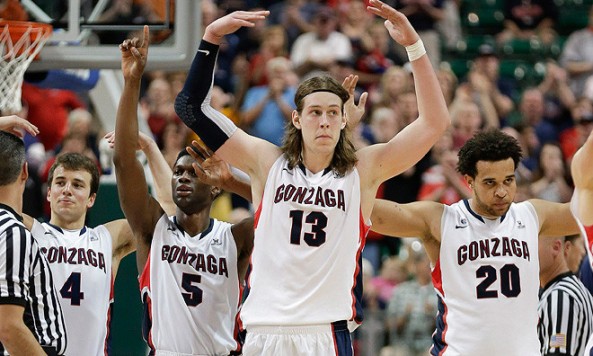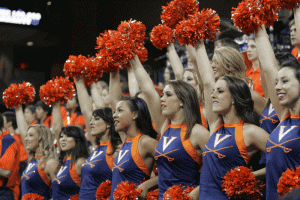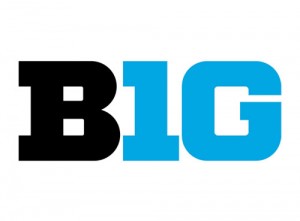Plenty of college basketball fans have questioned the credentials of the Virginia Cavaliers and Wichita State Shockers this season. From this vantage point, both teams fully deserved and earned their No. 1 seeds, but that’s not a unanimous sentiment across the college basketball landscape. At any rate, the Cavs and Shox raise the question: What are the weakest No. 1 seeds since the NCAA tournament field was expanded to 64 teams in 1985?
*
This subject is a delicate one for plenty of reasons. First of all, it’s fairly common for the fourth top seed to be weaker than the other three — there’s nothing particularly novel about that. Second, plenty of powerful 1 seeds have endured historic, stunning, and immensely disappointing losses (two examples: 1998 Arizona against Utah; 1994 North Carolina against Boston College) while other top seeds with less talent have made their way to the Final Four and even the national title (think of 2010 Duke).
An historically weak 1 seed should own more than one profound limitation in order to be seen as frail on a larger scale. The team’s regular season profile, its performance within the NCAA tournament, and its relationship to other top seeds since 1985 should all be part of the discussion… and the final evaluations. This is a subject which lends itself to intense debate, but the key distinction to make at the outset is that a list of the weakest No. 1 seeds is going to be entirely different from a list of the most disappointing No. 1 seeds.
Here are the 10 weakest top seeds in the Big Dance since the expansion to 64 teams in 1985:
10 – 2013 GONZAGA
Yes, Gonzaga merited strong consideration for a No. 1 seed when Selection Sunday 2013 arrived. The Zags had one of the six best resumes in the country last season. However, Miami and Duke both produced more high-end wins. Gonzaga beat Kansas State (a 4 seed that got bounced in the round of 64 in a virtual home game against La Salle) and Oklahoma State (a 5 seed that also lost in the R-64)… and that was it as far as GU’s big victories were concerned.
Mark Few’s team gained a top seed in a fashion similar (though not identical) to 2014 Wichita State: It just didn’t lose many games. In a non-power league (the West Coast Conference) that placed only one other team in the 2013 Big Dance (Saint Mary’s won a First Four game and then lost in the R-64 to Memphis), “avoiding losing” can certainly translate into a high seed… but does it create a strong team?
In the 2013 NCAAs, Gonzaga struggled for all 40 minutes with Southern, coming close to being the first top seed to lose to a 16 seed. Other top seeds — including really good ones such as 1989 Georgetown and 2013 Kansas — have had trouble winning their 1-16 games. However, when a 1 seed struggles with a 16, it can dispel doubts about its quality and heft by winning its round-of-32 game against the 8-9 winner. Last year’s Kansas team and 1989 Georgetown took care of business on that front.
Gonzaga did not.
The Bulldogs looked ordinary in two NCAA games last season, not just one. That, more than anything else, merits inclusion on the list of weakest 1 seeds in the 64-plus-team era of the Dance.
9 – 2000 ARIZONA
The Wildcats were thoroughly contained and controlled by Dick Bennett’s Wisconsin system in the round of 32 in Salt Lake City. Arizona’s place on this list will become much more apparent when you read about the Pac-12’s other weak 1 seed from the 2000 NCAA Tournament.
8 – 1994 MISSOURI
The Missouri Tigers are a rarity on this list in one specific respect: They made the Elite Eight. How can a 1 seed be viewed as historically weak when it came within one win of the Final Four and finished the regular season No. 2 in the RPI pecking order?
This team just didn’t defend very well… at least in the NCAA tournament.
The Tigers allowed 96 points in the round of 32, but won because of a 109-point explosion. In the Sweet 16, though, it became apparent that Mizzou was the equal of fourth-seeded Syracuse in a game where seeds didn’t matter. You’ll sometimes see tournament games in which an 11 seed has just as much talent as a 3, or a 7 has just as much talent as a 2, but 1 seeds — if not more skilled than 4 seeds — should at least be able to convey the impression that even though a game didn’t proceed as smoothly as possible, it would ordinarily beat a 4.
Missouri did not do that in a wobbly defensive performance against Syracuse in Los Angeles, a game the Tigers somehow won in overtime, 98-88.
Coach Norm Stewart’s team had a chance to show a sturdier side of itself in the West Regional final against Arizona, but it got torn apart, 92-72, in a game that was reflective of the disparity in quality between the two sides. Mizzou didn’t suffer the early exits of most of the other teams on this list, but it ended its NCAA tournament having shown that it was far more vulnerable than a 1 seed generally ought to be.
7 – 1989 OKLAHOMA
The Sooners, like Georgetown in that same NCAA tournament, won their first-round game by one point over a 16 seed. Billy Tubbs’s OU crew squeaked by East Tennessee State in Nashville, 72-71. The Sooners did annihilate Louisiana Tech in the R-32, but when they got to the Sweet 16, a prepared and disciplined Virginia squad handled them in Rupp Arena. The East Tennessee State game was a one-day accident; fair enough. Yet, the Sweet 16 loss suggested that Oklahoma didn’t rise to the standard a 1 seed is supposed to establish. (OU lost to North Carolina in the R-32 as a 1 seed the next year, in 1990. You could take your pick of these two OU teams.)
6 – 2005 WASHINGTON
The Huskies’ selection as a No. 1 seed came as a shock to most of the country in 2005. When Louisville, a severely underseeded 4 (hmmm — sound familiar?), whacked U-Dub by a 93-79 score in the Sweet 16, it was hard to deny the notion that the seedings for the 2005 tournament were not as accurate as they could have or should have been.
Interestingly enough, Washington and coach Lorenzo Romar came much closer to the Elite Eight when seeded fifth (in 2006). Former UW coach Bob Bender came within one Rip Hamilton jumper (or one Todd MacCulloch rebound) of the Elite Eight in 1998 as an 11 seed. Life is strange… especially within the context of the NCAA tournament.
5 – 2000 STANFORD
The Cardinal were one of two top seeds from the Pac-12 (then Pac-10) in 2000. Arizona was the 1 seed in the West, and it got knocked out of the tournament in the round of 32 by Wisconsin.
Stanford was lower on the 1 line than Arizona, reflected by the fact that it got shipped to the South Region. This gives you an indication of how bad a year 2000 was for every top seed other than Michigan State, the team that cut down the nets at the end of the Final Four in Indianapolis. Stanford had a chance to show that it had more staying power than Arizona in 2000, but it also lost in the R-32, to North Carolina in Birmingham.
The Cardinal went 0-2 against Arizona in 2000. They played only three non-conference opponents (Duke, Iowa and Auburn) that were above 137 in the RPI that season. Yes, they were a weak 1 seed on multiple fronts.
4 – 1985 MICHIGAN
The first NCAA tournament with a 64-team field came in 1985. The newness of the event in its expanded form makes it a little bit harder to place this Michigan team on this list. If there had been prior examples of a 1 seed struggling with a 16 and an 8 on the same weekend, perhaps Michigan’s place on this list would be different. At any rate, facts are facts, and Michigan did not score one point more than the two-team combination of Fairleigh Dickinson and Villanova. Michigan played two 59-55 games. It beat FDU and lost to Rollie Massimino’s team. When your NCAA tournament aggregate score is 114 for and 114 against, you’re not a strong 1 seed.
3 – 1991 OHIO STATE
The Buckeyes were a strong 1 seed in 1992, but in order to become the team they became that year, they had to absorb punishment in 1991. Ohio State inched past Georgia Tech by four points in the R-32, but when it arrived at the Midwest Regional semifinals in the Pontiac Silverdome — near its backyard and with a substantial partisan-crowd advantage — Malik Sealy’s St. John’s team was not impressed. Lou Carnesecca’s last great SJU team demolished the Buckeyes, 91-74. When a 1 seed takes that kind of thumping in the Sweet 16, a place on this list is in order.
2 – 1990 MICHIGAN STATE
The Big Ten owns the final few spots on this list. Coincidence? Maybe at the 3 and 4 spots, but not in terms of the top two.
First, a word about this 1990 Michigan State team: It had more than a little heart. Jud Heathcote got this roster to perform with uncommon resilience. Moreover, it should have played Minnesota in the Louisiana Superdome for the right to go to the Final Four. There’s no way Kenny Anderson’s shot at the end of regulation beat the horn; the two-point field goal should not have counted, and Sparty should have been awarded a victory over Georgia Tech.
Nevertheless, this was one of the weaker “ones” the NCAA tournament has seen over the past three decades. The Spartans were taken to overtime by 16th-seeded Murray State. Yes, there is a recorded instance of a 16 taking a 1 beyond 40 minutes, and the 1990 NCAAs witnessed it.
When Michigan State stopped exhaling with relief, the Spartans might have hoped to beat Cal-Santa Barbara by a wider margin in the R-32. Nope — they won by only four points (62-58), the same as their 75-71 margin over Murray. Georgia Tech, as you might recall, fielded a 1990 roster with the aforementioned Anderson, Dennis Scott, and Brian Oliver. Michigan State had Steve Smith in the fold, but it did not have the most talented assemblage of players on the floor in the Superdome on that controversial Friday night.
This team deserved so much better from officials and game administrators; yet, it was conspicuously weak as far as No. 1 seeds are concerned.
1 – 1996 PURDUE
Given the direction in which Purdue Basketball is headed, being a weak 1 seed qualifies as a “first-world problem” for the Boilermakers in a larger context. Anybody and everybody in a power conference would love to have this problem and the historical distinction that comes with it. Yet, if we’re looking at the past 29 NCAA tournaments dating back to 1985, it’s hard to recall a 1 seed that was more… well… ordinary than 1996 Purdue. The 1994 Boilermakers were a powerhouse 1 seed, fueled by the energy and anger of the Big Dog, Glenn Robinson. The 1996 team simply could not separate itself from 16th-seeded Western Carolina in Albuquerque.
What was striking about that game is that Purdue wasn’t able to distance itself from Western Carolina on three separate fronts: free throw attempts (16-15 for Purdue), offensive rebounds (9-9); and field goal percentage (53.8 for Purdue, 50 for Western Carolina). Usually, a 1 seed — even if it struggles in other aspects of competition — will be able to make a dent in a 16 seed in some way. This game looked and felt even all the way… and the box score reflected as much.
Purdue had a chance to show that the Western Carolina game was an aberration, but Georgia didn’t even need a last-minute miracle of any sort to pull an 8-over-1 upset in the R-32. The Bulldogs posted a 76-69 win to make the Boilermakers “number one” on this list of teams seeded number one.
Freelance writer-researcher Chris Abshire contributed information that was used in this report.

























